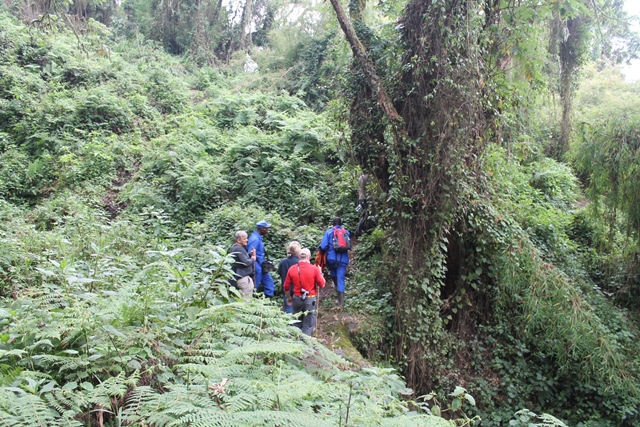
The gorilla trekking is a bucket list wildlife adventure that many plan to tick off when visiting Africa. And so, after booking the gorilla trekking trip in Rwanda and Uganda, one is filled with anticipation and can’t wait to meet the silverback gorilla and his family in their African jungle home.
As you prepare for your gorilla adventure it is important to get acquainted with the rules or guidelines of gorilla trekking. The rules or guidelines are set by the park to limit the impact of the tourism on the gorillas and their home. The aim is to leave only footprints!
The guidelines are also to keep the tourist safe, and also to have a comfortable gorilla trekking experience in the African jungle and across a type of terrain that perhaps one has never hiked.
These gorilla trekking rules and guidelines will also be discussed during the briefing of the tourists in the morning before setting off for the gorilla trek. But it is important to have a grasp of them before the gorilla trip as by the time of the briefing at the park the adrenaline is high and may not be too attentive.
The gorilla trekking rules and guidelines in Rwanda and Uganda
Guidelines before going into the forest
Before going out into the forest to start the hike the park guide will ask if everyone is possession of these items;
- Lunch box: A lunch box should be in hand as the duration of the gorilla trek is unpredictable, so you will have time for picnic lunch in the jungle. This often while on your back after seeing the gorillas
- Drinking water at least 2 liters: You will need to constantly rehydrate during the hike. You also hike in high altitude and constant rehydration is vital in preventing altitude sickness.
- Comfortable hiking shoes: Very vital for the terrain that may be wet and slippery.
- A rain jacket: The weather in the rainforest and highlands tends to be volatile and can in instant unexpectedly release a shower on a sunny day. Read when to do the gorilla trek to learn about the weather patterns.
- Day pack: This is to carry your possessions such as camera and phones, rain jacket, lunchbox etc…
- Porter: hiring a porter ($15) will be highly recommended by the park guide. The porter will carry your daypack and any other items to take any extra weight from you so you can easily hike. Porter can also provide a push or pull when you need it. You can however opt to do without the porter if you can manage.
Sick people are not allowed to the gorilla trek. The park guide will ask those who do not feel to voluntarily report themselves and excuse themselves from tracking. A refund on the gorilla trekking permit is given to once who cancels the trek due to illness.
Also, only persons aged 15 and above are allowed to do the gorilla trekking. Children are exempted from the gorilla trek for a number of reasons such as; the trek being difficult, children are susceptible to diseases such as measles, mumps, cough which they can spread to the gorillas, and children do have the discipline to stay calm which is important for safety when with the gorillas
While trekking in the jungle you will observe the following guidelines;
Do not leave your turd on top. If you want to defecate the park guides will dig a hole in the ground for you to defecate in after which it should be covered with the soil. This is to prevent spreading diseases.
Do not liter in the forest.
Do not take anything from the park. You may want to pick a nice plant, fruit or flower, please do not! You may be taking away critical habitat and food for the gorillas.
When you meet the gorillas you will observe the following rules and guidelines

- Keep at least 7 meters from the gorillas. If a gorilla moves closer, move back and if it continues your direction step aside and give way or move until you can’t move anymore.
- In case the gorilla (silverback) gets an interest in you and moves so close as touching you, crouch down and do not make any movement (read here on what to do when encountering the gorillas)
- Do not be tempted to touch the gorilla. The young ones are often curios and can move close to you and even poke a finger on you. Stay still until it moves back.
- Do not use flash with the camera. It is found to agitate the silverback gorilla and may trigger the gorilla into charging.
- Do not look the silverback gorilla in the eyes, or avoid a long stare. The eye to eye look in the silverback gorilla communicates a challenge to the gorilla which he may take and charge you
- Keep your voice low. Noise may unsettle the gorillas causing them to flee or cause an attack from the silverback gorilla
- Do not make sudden movements when near the gorillas. This will scare the gorillas.
- Do not eat around the gorillas. The gorillas may find leftovers and eat them which would introduce them to another diet. The gorillas have a strict diet of plants and fruits unique to their surrounding that a change in diet could have fatal effect. The leftover may also transmit diseases to the gorillas.
- Do not sneeze in the face of the gorillas. If you fill an itch in the nose and feel you are about to let out a sneeze, turn your head away and sneeze inside your elbow or better in a handkerchief.
Leave a comment Cancel reply
Archives
- June 2025 (1)
- March 2025 (1)
- February 2025 (1)
- January 2025 (1)
- November 2024 (2)
- October 2024 (3)
- May 2024 (1)
- February 2024 (1)
- January 2024 (2)
- November 2023 (2)
- September 2023 (1)
- July 2023 (8)
- June 2023 (14)
- May 2023 (1)
- April 2023 (1)
- March 2023 (3)
- February 2023 (6)
- January 2023 (6)
- December 2022 (1)
- November 2022 (1)
- October 2022 (2)
- September 2022 (1)
- August 2022 (1)
- May 2022 (17)
- April 2022 (5)
- March 2022 (7)
- February 2022 (3)
- January 2022 (7)
- December 2021 (7)
- November 2021 (2)
- October 2021 (1)
- September 2021 (2)
- August 2021 (2)
- July 2021 (6)
- June 2021 (1)
- May 2021 (4)
- April 2021 (3)
- March 2021 (2)
- February 2021 (2)
- January 2021 (14)
- November 2020 (2)
- September 2020 (1)
- March 2020 (1)
- February 2020 (1)
- August 2019 (1)
- September 2016 (1)
- June 2016 (1)
- May 2016 (1)

